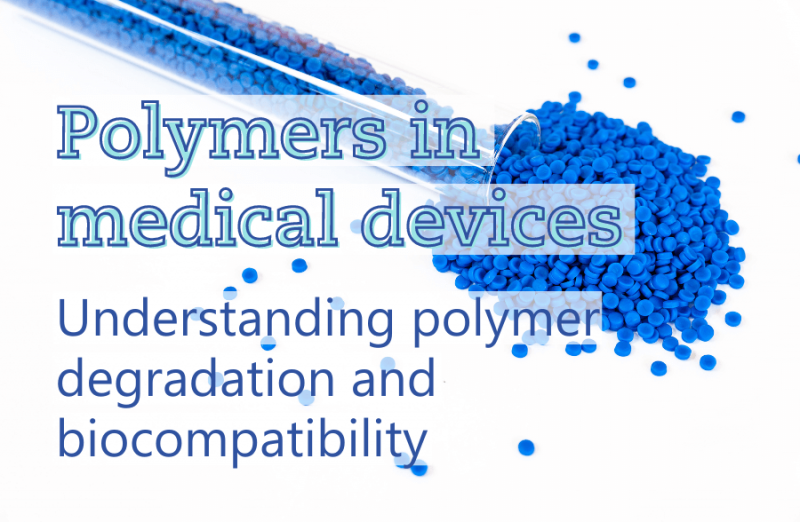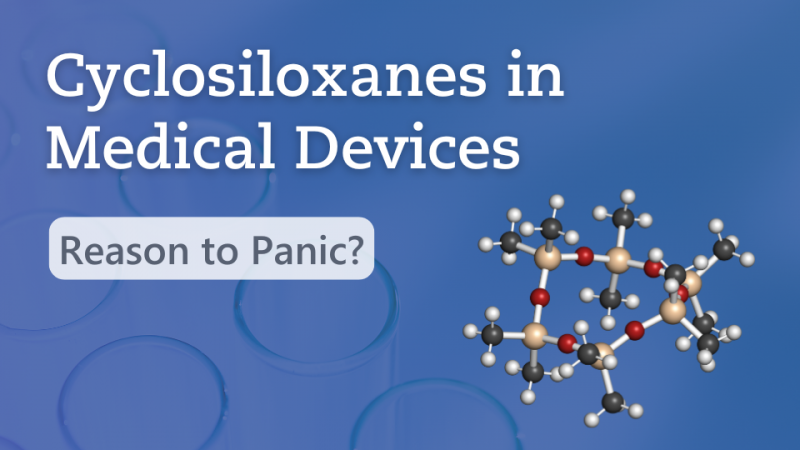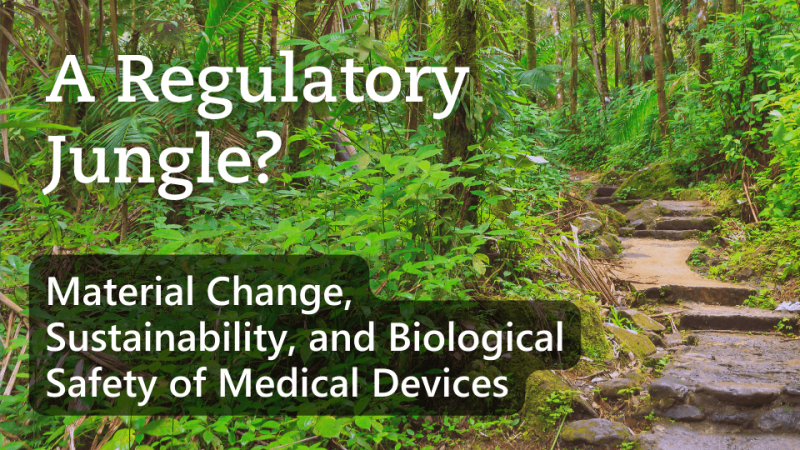Polymers in Medical Devices: Understanding polymer degradation and biocompatibility
10/07/2023
Do you have any questions about the article or would you like to find out more about our services? We look forward to hearing from you!Make a non-binding enquiry now
Whether in packaging, single-use products or implants, polymers can be found in a variety of medical devices. However, they pose unique challenges in terms of risk management and biological safety, especially when it comes to polymer degradation. This article summarizes important requirements for test systems for the biocompatibility assessment of polymers and their degradation products according to ISO 10993-1, ISO 10993-13, and ISO 14971. Furthermore, typical pitfalls in the development of testing strategies will be discussed along with advice on how medical device manufacturers can best address these issues.Before discussing polymers in medical devices, it is important to understand the following background information: Polymers (Greek: "poly" = many, "meros" = part) possess a range of special properties. As high molecular-weight chemical compounds (macromolecules), they are synthesized through a directed, mostly covalent linkage of their basic building blocks (monomers). A crucial parameter in their production is achieving a sufficiently high degree of polymerization, so that the physicochemical properties of the resulting molecule no longer change with the addition of further repeating units. While polymers are considered "stable" after their synthesis, they can undergo degradation processes due to chemical exposure and/or physical influences. This polymer degradation can be intentionally utilized to achieve the desired purpose of a medical device. However, unintended degradation can also occur. Therefore, when considering the application of polymers in medical devices, it is important to examine, test, and evaluate their unintended degradation products.
Best Regards
 Dr. Carolin Schilpp
Dr. Carolin Schilpp
Polymers: Wide application in medical devices
Since the 1960s, synthetic polymers have found their way into clinical applications. While single-use products were initially in focus, nowadays a wide variety of polymers are used in many different applications. The main uses medical devices containing polymers include:- Therapeutic systems for drug administration, such as infusion sets.
- Diagnostic aids for clinical laboratory testing, such as blood collection tubes.
- Implants for short-term and long-term use, such as artificial heart valves or catheters.
- Coatings of medical devices, such as polytetrafluoroethylene as an anti-adhesion coating.
- Primary packaging of medical devices.
Complex requirements for polymers in medical devices
Polymers used as medical devices in clinical settings are subject to a number of additional requirements that go beyond specifying their material properties. These include:- biocompatibility,
- processability with conventional manufacturing methods,
- sufficient high mechanical properties,
- potential sterilizability,
- potential reprocessing capability and
- stability over the intended period of use.
Polycarbonate and Bisphenol A: A practical example of polymer degradation
When using polymers in medical devices, an adequate analysis is important for identifying and quantifying possible intermediate and/or degradation products. The example of polycarbonate and the Bisphenol A (BPA) used in its production illustrates the complex challenges of polymer degradation.- Polycarbonates, due to their high resistance, are used in many single-use medical devices. They are typically produced through the polycondensation of BPA and phosgene.
- However, BPA can have adverse effects on the hormonal system or organs such as the kidney and liver.
- At high temperatures, such as those generated during molding by injection molding, polymer chains can break and release Bisphenol A (BPA). However, subsequent cleaning steps can usually reduce BPA contamination on the surface (verification required). Nevertheless, the leaching of BPA can pose biocompatibility hazards and may indicate a change in the mechanical properties of the polymer itself.
- Special additives can prevent the leaching of BPA and maintain mechanical properties by stabilizing the polymer during manufacturing processing or by helping to prevent UV-degradation. However, these additives can also potentially pose risks to patients. Therefore, it is important to know exactly which additives are used and how they perform over time. This requires careful analysis and evaluation of the additives to avoid potential hazards during use.
- The main challenge lies in the final sterilization process, where temperatures of up to 137°C can be reached (depending on the method) under steam saturation and pressure. High temperatures combined with steam can also cause leaching of BPA, which remains in the end product and can potentially be released in the patient. Therefore, when using polycarbonate, steam sterilization should be avoided where possible and ethylene oxide sterilization should be used instead. In the case of ethylene oxide sterilization, residues on the product must be analyzed, and they must not exceed certain limits.
- Special attention should be given to the shelf life of sterile single-use products containing polycarbonate. During storage, medical devices may be exposed to certain environmental factors that may have an impact on the materials used. Therefore, before placing them on the market, it must be tested whether any degradation products have formed during storage.
- The same applies to reusable medical devices. After the maximum number of reprocessing cycles, an analysis of degradation products must be conducted.
ISO 10993-13: Test systems for identification and quantification of polymer degradation
This example demonstrates the complex questions that polymer degradation can raise. What do these questions mean for medical device manufacturers? In general, regardless of whether polymer degradation occurs in a planned or unplanned way, an initial material characterization should be conducted for all possible polymer products (starting polymer, intermediate products, and, if possible, degradation products). This is followed by the analysis described in ISO 10993-13 (Qualitative and quantitative determination of degradation products from polymers in medical devices), which contains the following content:- possible analytical methods,
- possible solvents depending on the type of degradation (hydrolytic or oxidative),
- possible test devices and accessories,
- general instructions for experimental design (number, size, mass/volume ratio, etc.),
- information on accelerated degradation and its test setup,
- information on real-time degradation and its test setup and
- analysis and evaluation.
- ISO 10993-1 - Evaluation and testing within a risk management process.
- ISO 10993-6 - Tests for local effects after implantation.
- ISO 10993-7 - Ethylene oxide sterilization residuals.
- ISO 10993-9 - Framework for identification and quantification of potential degradation products.
- ISO 10993-12 - Sample preparation and reference materials.
- ISO 10993-16 - Toxicokinetic study design for degradation products and leachables.
- ISO 10993-17 - Establishment of allowable limits for leachable substances / Toxicological risk assessment of medical device constituents.
- ISO 10993-18 - Chemical characterization of medical device materials within a risk management process.
ISO 10993-1: Evaluation of the biocompatibility of polymers and their degradation products
As with all materials, ISO 10993-1 provides the general framework for evaluating the biocompatibility of polymers. Polymers are assessed within a risk-based approach according to ISO 14971, taking into account the following factors:- The nature and duration of contact with the body,
- available data and
- identified risks.
Challenges and pitfalls in test systems for biocompatibility
When selecting test systems for the biocompatibility assessment of polymers, it is important to consider the usage of the device and design the appropriate corresponding test. One key aspect, for example, is whether the degradation products remain static at a specific location (e.g., application in a joint) or are dynamically distributed throughout the body. Depending on the application, degradation products can be released rapidly or slowly from the medical device. Therefore, when choosing the appropriate test system, it is crucial to consider the release rate.Rapid release can temporarily increase the concentrations of one or more substances, which can in turn alter the pH value and/or osmolality (total number of dissolved substances in a liquid solution) in a static in vitro test system. Under dynamic conditions, the static approach can lead to distorted results. Therefore, it is important to maintain physiologically relevant conditions in these experiments. The experimental setup should be designed in such a way that observed effects can be directly attributed to the degradation products, and any result distortion due to potential artifacts is eliminated.Given these challenges, comprehensive documentation with justification of the chosen approach and parameters, including a thorough evaluation of the experimental validity, is essential. For the latter, comparing the standard test system with the adapted test system could be suitable. This would allow for the consideration of effects that would specifically occur in the standard system but may not fully apply to the real usage of the device.Conclusion
Polymers are present in a wide range of medical devices today. They exhibit a high degree of heterogeneity in terms of properties and degradation behavior. Important challenges in evaluating the biocompatibility of medical devices containing polymers are their intended or unintended degradation products. When planning the corresponding test systems, it is necessary to consider numerous standards as well as a multitude of special aspects that are significantly more complex than those needed for other materials, such as metal alloys. Therefore, it is recommended to involve experienced professionals for the biocompatibility testing of polymers in medical devices.Are you currently facing the challenge of assessing the biocompatibility of a new medical device containing polymers? Do you have uncertainties regarding potential degradation products? Or are you in the process of developing a suitable testing strategy for the biocompatibility of your medical devices and are looking for experienced experts in the field? Our team is ready to support you and work with you to develop tailored solutions for your needs. We look forward to hearing from you for an initial consultation, free of charge and without obligation.Best Regards
Our blog posts are researched and created with the utmost care, but are only snapshots of the regulations, which are constantly changing. We do not guarantee that older content is still current or meaningful. If you are not sure whether the article you have read on this page still corresponds to the current state of regulation, please contact us: we will quickly place your topic in the current context.

Biological Safety Expert
Regulatory Affairs & Technical Documentation


